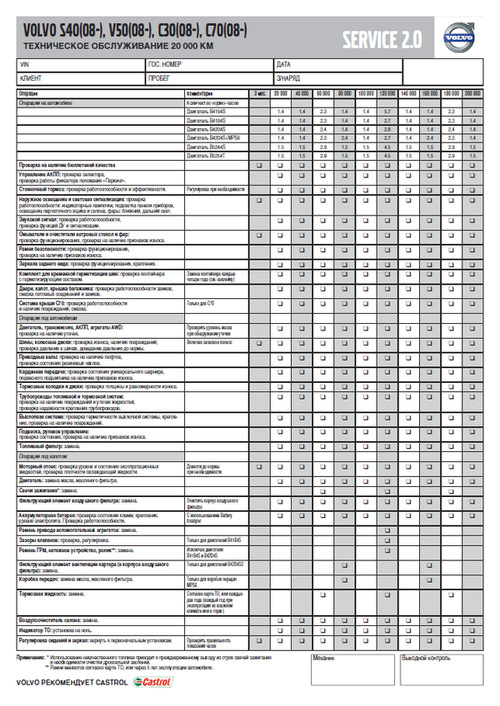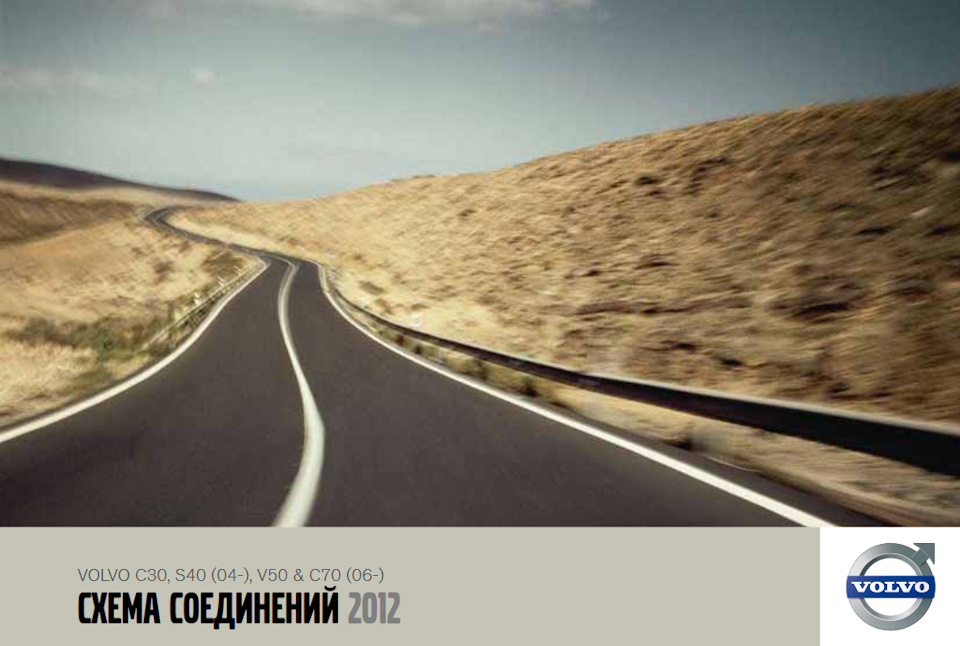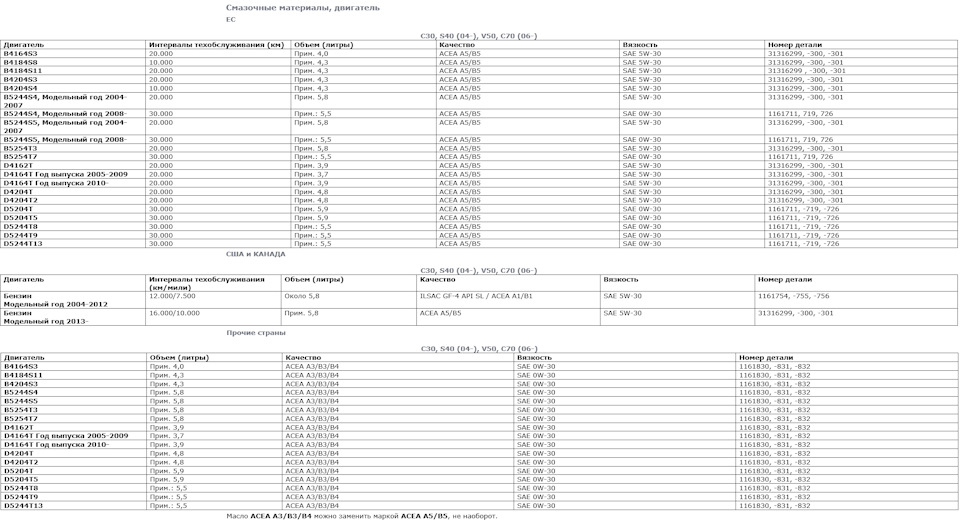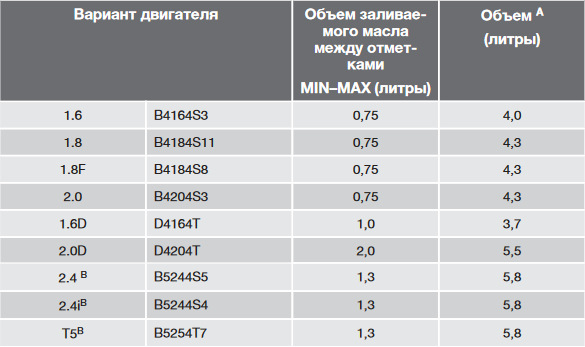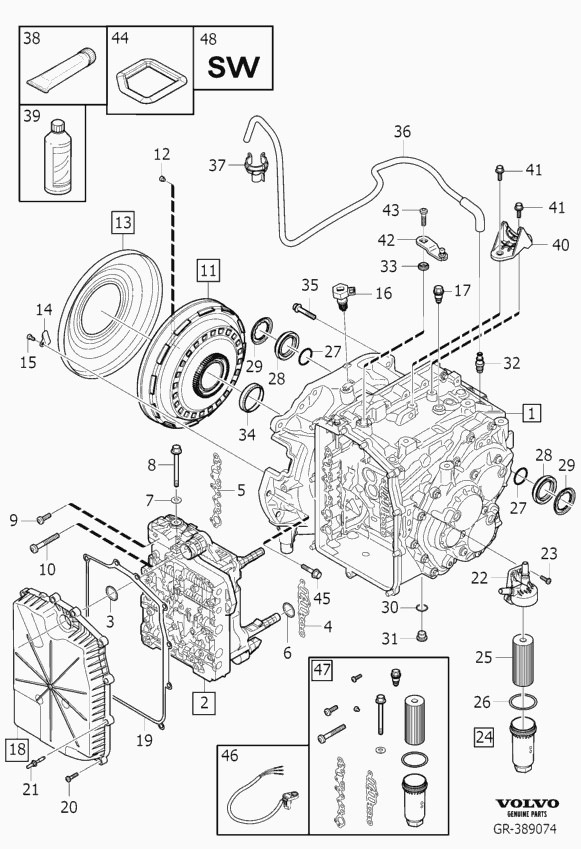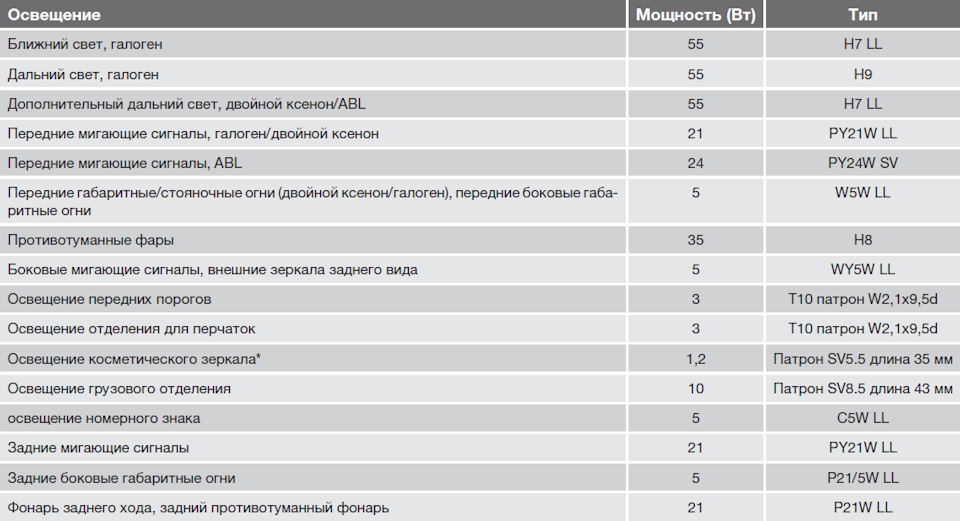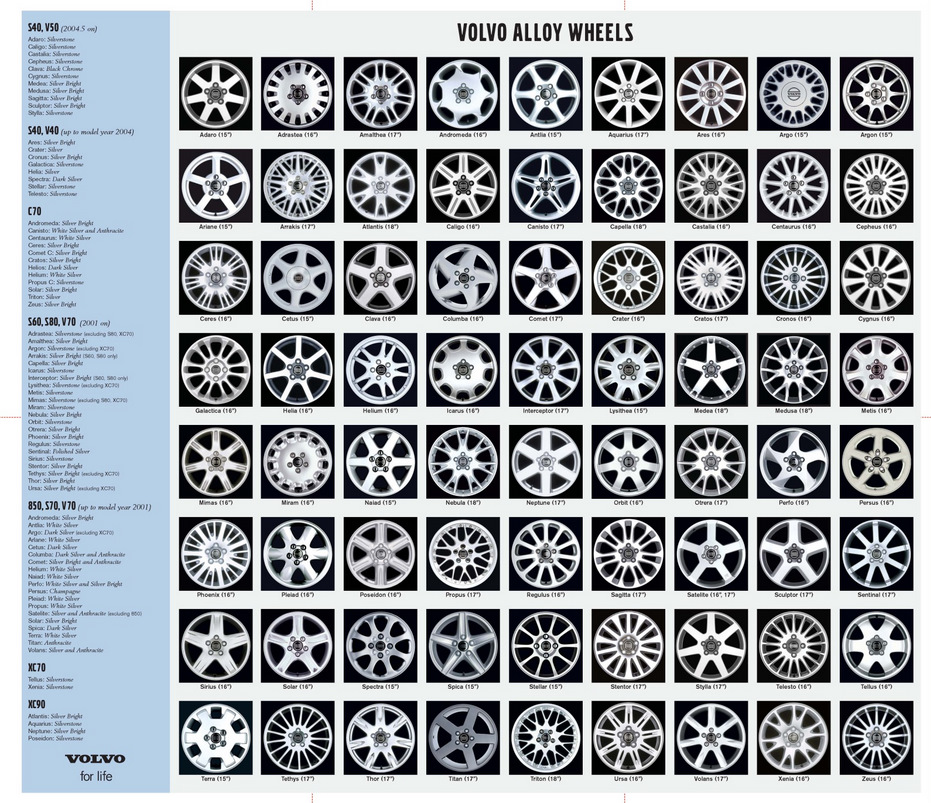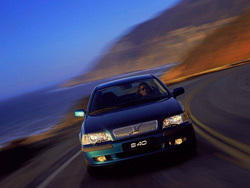Всем доброго дня!
Для удобства использования решил собрать в данной записи документацию, технические характеристики, мануалы, руководства, инструкции и прочий полезный материал для своей машины, найденные за несколько лет на просторах интернета. Предвижу, что данная подборка для местных олдовых корифеев покажется несколько скучной, тем не менее, не исключаю, что для кого-то она также может быть информативной и полезной. Информация актуальна для владельцев автомобилей Volvo C30/S40/V50/C70.
— Регламентированный перечень работ по ТО
Регламентированный перечень работ по ТО для Volvo C30/S40/V50/C70
Ссылка на файл в формате PDF (ОД Обухов)
— Каталоги запчастей и аксессуаров Volvo
Carcats.ru
Elcats.ru
Emex.ru
accessories.volvocars.com — официальный каталог аксессуаров
Инструкция подбора запчастей и комплектующих Volvo по VIN-номеру — Часть 1, Часть 2
— Руководство/инструкция по эксплуатации
Ссылка на руководство для Volvo V50 MY2012
Ссылка на руководства для других моделей и/или модельных годов
Ссылка на различные инструкции для всех моделей Volvo (Eng, официальный сайт Volvo)
Ссылка на различные инструкции для Volvo S40/V50 (Eng, ресурс владельцев Volvo в UK)
— Quick Guide
Ссылка на файл в формате PDF
— Схемы соединений проводки (Электрика)
Полный размер
Схема по электрической проводке для Volvo C30/S40/V50/C70
Ссылка на файл в формате PDF
— Характеристики и годы производства двигателей для Volvo C30/S40/V50
Характеристики и годы производства двигателей для Volvo C30/S40/V50
Ссылка на источник
— Технические характеристики бензиновых двигателей 2.4 (B5244S4/B5244S5) и 2.5 (B5254T3)
Manual Volvo C30/S40/V50 engines B5244S4 and B5254T3
Ссылка на файл в формате PDF (Eng)
— Технические характеристики бензинового двухлитрового двигателя B4204S3 (он же Mazda MZR LF 2.0, он же Ford Duratec HE 2.0)
Ссылка на изображение в полном размере (источник VIDA)
Ссылка на подборку полезной информации о двигателе Volvo B4204S3/Mazda MZR LF 2.0/Ford Duratec HE 2.0
— Моторное масло
Моторное масло — объём, допуск, эксплуатационные свойства, вязкость, артикулы канистр для бензиновых двигателей B4164S3, B4184S8, B4184S11, B4204S3, B4204S4, B5244S4, B5244S5, B5254T3, B5254T7 и дизельных двигателей D4162T, D4164T, D4204T, D4204T2, D5204T, D5204T5, D5244T8, D5244T9, D5244T13.
Полный размер
Моторное масло для двигателей Volvo C30/S40/V50
Ссылка на изображение в полном размере (источник VIDA)
— Объём масла между минимальной и максимальной отметками на щупе двигателей Volvo C30/S40/V50
Объём масла между минимальной MIN и максимальной MAX отметкой на щупе моторов Volvo C30/S40/V50
— Автоматическая 5-ти ступенчатая коробка передач Aisin AW55-50/51SN
Запчасти на фото: 0835631, 303943
Ссылка на каталог запчастей в формате PDF (Eng)
Ссылка на мануал в формате PDF (Eng)
— Роботизированная 6-ти ступенчатая коробка передач Getrag 6DCT450 (MPS6, она же PowerShift)
Серия публикаций о PowerShift от технического специалиста Сергея glimmer:
Эксплуатация PowerShift (6DCT450)
Функции коробки PowerShift (6DCT450)
Принцип работы Powershift 6DCT450
Замена масла в коробке PowerShift (6DCT450)
VIDA 2021: Инструкция по замене масла АКПП PowerShift (6DCT450) — NEW!
Замена сцепления 6DCT450 и Eco Boost 203(240)л.с)
Замена уплатнения сцепления 6DCT450 и Eco Boost 203(240)л.с
Модуль управления коробки передач (TCM). Часть 1
Модуль управления коробки передач (TCM). Часть 2
Модуль управления коробки передач (TCM). Замена датчика входного вала
Powershift 6DCT450 в деталях. Часть 1
Powershift 6DCT450 в деталях. Часть 2. Принципиальные схемы ТСМ
Powershift 6DCT450 в деталях. Часть 3. Демпфер.
Powershift 6DCT450 в деталях. Часть 4. Соленоиды ТСМ.
— Типы цоколей и мощность ламп
Полный размер
Типы цоколей и мощность ламп
— Брошюра Volvo V50 (Volvo Cars Russia)
Полный размер
Брошюра Volvo V50 (Volvo Cars Russia)
Скачать в формате PDF — описание, фото, комплектации, экстерьер, интерьер, аксессуары
— Официальные пресс-релизы и фото Volvo V50 (Volvo Cars)
Ссылка на официальные пресс-релизы, фото и видео
— Каталог оригинальных литых дисков Volvo (артикулы и размерность)
Каталог оригинальных литых дисков Volvo
Ссылка на каталог — названия дисков, размерность и артикулы
— Комплектации Volvo V50
Ссылка
— Проверка доступности обновлений Service 2.0 для всех автомобилей Volvo по VIN-коду
Обновления Volvo Service 2.0
Ссылка
— Расшифровка информации о комплектации для всех автомобилей Volvo по VIN-коду
Ссылка на форму отправки запроса на расшифровку информации по VIN-коду в ОД Volvo Car M1
— Volvo VIDA
VIDA Online (для пользователей clubvolvo.ru)
VIDA 2014D + DiCE (Установка, настройка и использование)
— Кузов
Полный размер
Размеры кузова Volvo V50
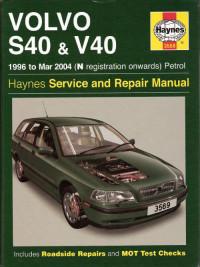
Руководство на английском языке по техническому обслуживанию и ремонту автомбилей Volvo S40 и Volvo V40 1996-2004 годов выпуска с бензиновыми двигателями.
- Автор: —
- Издательство: Haynes Publishing
- Год издания: —
- Страниц: 308
- Формат: PDF
- Размер: 57,6 Mb
Мультимедийное руководство на английском языке по техническому обслуживанию и ремонту автомбилей Volvo S40 и Volvo V40.
- Автор: —
- Издательство: Mitchell
- Год издания: —
- Страниц: —
- Формат: ISO
- Размер: 661,9 Mb
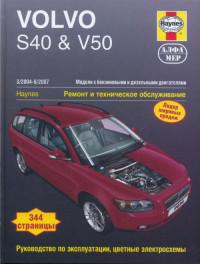
Руководство по эксплуатации, техническому обслуживанию и ремонту автомбилей Volvo S40 и Volvo V50 2004-2007 годов выпуска с бензиновыми и дизельными двигателями.
- Автор: —
- Издательство: Алфамер Паблишинг
- Год издания: —
- Страниц: 320
- Формат: PDF
- Размер: 122,7 Mb
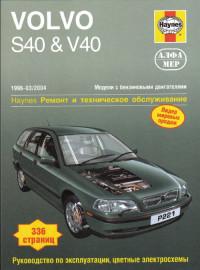
Руководство по эксплуатации, техническому обслуживанию и ремонту автомбилей Volvo S40 и Volvo V40 1996-2004 годов выпуска с бензиновыми двигателями.
- Автор: —
- Издательство: Алфамер Паблишинг
- Год издания: —
- Страниц: 295
- Формат: —
- Размер: —
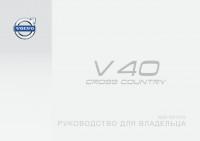
Сборник руководств по эксплуатации и техническому обслуживанию автомбиля Volvo V40 Cross Country 2014-2015 годов выпуска.
- Автор: —
- Издательство: Volvo Car Corporation
- Год издания: 2013/2014
- Страниц: 540/472
- Формат: PDF
- Размер: 23,6 Mb
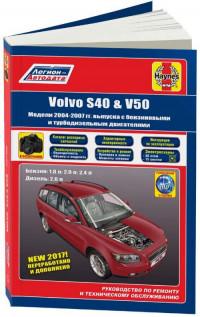
Руководство по эксплуатации, техническому обслуживанию и ремонту + каталог расходных запчастей автомбилей Volvo S40 и Volvo V50 2004-2007 годов выпуска с бензиновыми и дизельными двигателями.
- Автор: —
- Издательство: Легион-Автодата
- Год издания: —
- Страниц: 344
- Формат: —
- Размер: —
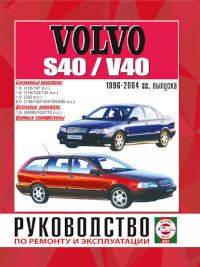
Руководство по эксплуатации и ремонту автомбилей Volvo S40 и Volvo V40 1996-2004 годов выпуска с бензиновыми и дизельными двигателями.
- Автор: —
- Издательство: Гуси-Лебеди
- Год издания: —
- Страниц: 280
- Формат: —
- Размер: —

Сборник руководств по эксплуатации и техническому обслуживанию автомбиля Volvo S40 с 2004 года выпуска.
- Автор: —
- Издательство: Volvo Car Corporation
- Год издания: 2003-2011
- Страниц: —
- Формат: PDF
- Размер: 66,1 Mb
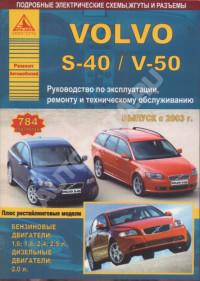
Руководство по эксплуатации, техническому обслуживанию и ремонту автомбилей Volvo S40 и Volvo V50 с 2003 года выпуска с бензиновыми и дизельными двигателями.
- Автор: —
- Издательство: Арго-Авто
- Год издания: —
- Страниц: 784
- Формат: —
- Размер: —


Данная инструкция на русском языке предназначена для автомобиля
Volvo S40 II (2007 — 2012), описывает принцип работы и основные моменты эксплуатации устройства.
Производитель настойчиво рекомендует перед включением автомобиля
внимательно изучить настоящую инструкцию.
Инструкция для автомобиля
представлена в формате PDF. Все современные браузеры уже поддерживают данный формат и сложностей с открытием файла возникнуть не должно.
Но если открыть инструкцию все же не удается, то необходимо установить на компьютер программу для чтения PDF файлов, например, Acrobat Reader. Если у вас возникли сложности с открытием инструкции на смартфоне под управлением Android, нужно установить, например, Adobe Acrobat Reader.
Комментарии (0)
Комментарии про другие Автомобили
Другие Автомобили Volvo
- Руководства по ремонту
- Руководство по ремонту Вольво С40 1996-2002 г.в.
Руководство по ремонту Volvo S40 / Вольво С40
Общая информация об автомобиле.
В сентябре 1995 года состоялся дебют модели S40. Изначально данная Volvo именовалась как S4/V4, но после того, как на шведов подали в суд за использование чужих аббревиатур (так обозначались спортивные модификации фирмы Audi), модель срочно переименовали в S40. В новом обозначении моделей буква указывает на тип кузова: S — седан, V — пикап и С — купе или кабриолет, а цифры означали номер модели. Новинка S40 полностью отличается от своих предшественников, как по дизайну, так и по устройству.
В качестве главной движущей силы к этой модели предлагались три типа двигателей: 2,0 л и 1,8 л бензиновые и 1,9 л турбодизельный.
Результатом трёхлетней работы, основанной на откликах покупателей, поступавших с 1995 года, стало новое поколение Volvo S40, которое появилось в 2000 году. На обновлённой модели было изменено более 1500 деталей, результатом чего являются более 30 серьёзных усовершенствований, которые распространились на безопасность, качество, экологические характеристики, динамические характеристики, комфорт и дизайн.
Volvo S40 — один из самых безопасных автомобилей среднего класса стал еще более безопасным, комфортабельным и удобным.
В изысканный дизайн модели были добавлены свежие штрихи: новые бампера, новые увеличенные боковые фонари, новые передние крылья, новые противотуманные фары, новые указатели поворотов и двойные фары, новые боковые молдингн, цвета, новые легкосплавные диски, новые прозрачные задние фонари, новая задняя панель и новый стеклоочиститель.
Колесная база увеличилась на 12 мм, длина автомобиля — на 33 мм, колея передних колес — на 18 мм.
Volvo S40 — единственный автомобиль в своем классе, на который устанавливается надуваемая занавеска безопасности (IC) в стандарте для всех вариантов исполнения. Также устанавливается двухуровневая подушка безопасности.
Множество изменений было сделано в ходовой части: новая подвеска передних колес, новые опоры двигателя, что значительно увеличивает комфорт при вождении, защиту от шума, а также управляемость на зимней дороге. Интерьер салона претерпел значительную модернизацию. Серьезно модифицировали центральную консоль: новая панель климат-контроля, новые положения органов управления, более удобная нижняя полка, новый дизайн аудиосистемы, органы управления окнами и зеркалами перенесены на двери. Добавили новую многофункциональную консоль над тоннелем, новые сидения и два новых вида обивки.
Volvo S40 — это переднеприводный автомобиль с поперечно расположенным четырехцилиндровым двигателем. На выбор предлагается один из трех бензиновых двигателей или дизельный двигатель. Версия с турбонаддувом обладает мощностью в 200 л.с.
Все эти двигатели реагируют очень быстро и мощно на движение педали акселератора. Что позволяет очень быстро набрать скорость при выходе из поворота или при обгоне грузовика. Это также означает меньшее количество переключений передач в городских условиях.
↓ Комментарии ↓
1. Общие сведения
1.0 Общие сведения
1.1. Паспортные данные
1.2 Общие требования к ремонту автомобиля
2. Эксплуатация и техническое обслуживание автомобиля
2.0 Эксплуатация и техническое обслуживание автомобиля
2.1 Органы управления и панель приборов
2.2 Замок зажигания
2.3. Управление наружным освещением
2.4 Стеклоочистители / омыватели ветрового стекла, стеклоочистители / омыватели фар
2.5 Предупреждающая световая (аварийная) сигнализация
2.6 Обогреваемое заднее стекло, обогреваемые наружные зеркала заднего вида
2.7. Использование информационного центра
2.8 Система удержания постоянной скорости движения (круиз-контроль)
2.9. Система DSA
2.12. Передние сиденья
2.17. Управление отоплением и вентиляцией
2.22. Автоматическая коробка передач
2.23. Тормозная система
2.24. Обслуживание аккумуляторной батареи и пуск двигателя от постороннего источника
2.27. Описание выполнения операций по техническому обслуживанию
2.28. Описание основных эксплуатационных материалов и их заправочных объемов
3. Конструкция и технические характеристики двигателей
3.0 Конструкция и технические характеристики двигателей
3.1 Общие сведения
3.2 Головка блока цилиндров
3.3 Блок цилиндров
3.4. Газораспределительный механизм
3.5. Кривошипно-шатунный механизм
3.6. Система смазки
3.7 Система питания
3.8 Система выпуска отработавших газов
3.9. Система охлаждения
4. Ремонт двигателя
4.0 Ремонт двигателя
4.1 Снятие головки блока цилиндров
4.2 Установка головки блока цилиндров
4.3. Снятие и установка опор двигателя
4.4 Снятие двигателя
4.5. Разборка и оценка состояния деталей двигателя
4.6. Сборка и установка двигателя
5. Трансмиссия
5.0 Трансмиссия
5.1 Общие сведения
5.2 Технические характеристики
5.3. Конструкция, проверка и замена сцепления
5.4 Заполнение и прокачка гидравлической системы сцепления
5.5 Регулировка педали сцепления
5.6 Замена рабочего цилиндра сцепления
5.7. Конструкция и замена элементов коробки передач
5.8. Механизм переключения передач
6. Тормозная система
6.0 Тормозная система
6.1 Общие сведения
6.2. Назначение и краткое описание элементов гидравлической системы рабочего тормоза
6.3 Электрическая система
6.4 Технические характеристики
6.5 Стояночный тормоз
6.6. Технологическое обслуживание и ремонт тормозной системы
7. Передняя подвеска и рулевое управление
7.0 Передняя подвеска и рулевое управление
7.1. Общие сведения
7.2. Технические характеристики
7.3. Техническое обслуживание и ремонт подвески
7.4. Техническое обслуживание и ремонт рулевого управления
8. Задняя подвеска
8.0 Задняя подвеска
8.1 Общие сведения
8.2. Техническое обслуживание и ремонт
9. Система управления двигателем Fenix 5.1
9.0 Система управления двигателем Fenix 5.1
9.1. Описание системы
9.2. Диагностика
10. Электрооборудование. Проводка и компоненты
10.0 Электрооборудование. Проводка и компоненты
10.1 Введение
10.2 Реле
10.3 Предохранители
10.4. Жгуты электропроводки и модули управления
10.5. Общие проверки
10.6. Технические характеристики основных элементов электрической сети
10.7. Технология замены элементов электрического оборудования
10.8. Механические проверки и регулировки
10.9. Расположение электрических компонентов на автомобиле и схемы их электрических связей
11. Кузов
11.0 Кузов
11.1 Общие сведения
11.2 Контрольные размеры кузова
11.3 Способы соединения деталей при восстановлении эксплуатационных качеств кузова
11.4. Ремонт кузова
11.5. Снятие и установка элементов кузова автомобиля
12. Схемы электрооборудования
12.0 Схемы электрооборудования
12.1 Схемы 1-10
12.2 Схемы 11-20
12.3 Схемы 21-32
- Manuals
- Brands
- Volvo Manuals
- Automobile
- S40 — ANNEXE 244
- Manual
2005
-
Contents
-
Table of Contents
-
Bookmarks
Related Manuals for Volvo S40
Summary of Contents for Volvo S40
-
Page 1
VOLVO WEB EDITION 2005… -
Page 2
Dear Volvo owner We hope you will enjoy many years of driving pleasure in your Volvo. The car has been designed for the safety and comfort of you and your passengers. Volvo is one of the safest cars in the world. Your Volvo has also been designed to satisfy all current safety and environmental requirements. -
Page 3
In addi- tion to standard equipment, this manual also describes options (factory fitted equipment) and certain accessories (extra equipment). NOTE! Volvo cars are adapted for the varying requirements of different markets, as well as… -
Page 4: Volvo Cars And The Environment
, a concept which means that you benefit example in heavy city traffic, tailbacks and activities of Volvo Cars. Volvo cars comply in two ways — from a clean cabin and a highly tunnels — while the carbon filter traps nitrogen…
-
Page 5
In terms of fuel economy, significantly higher fuel ies and oils, in an envi- Volvo cars are highly competitive in their consumption, they ronmentally safe man- respective segments. should be removed ner. -
Page 6: Table Of Contents
Contents Instrument overview Safety Instruments and controls Climate control Interior Locks and alarm Starting and driving Wheels and tyres Car care Maintenance and service Infotainment system Technical data…
-
Page 8: Instrument Overview
Instrument overview Overview, left-hand drive car Overview, right-hand drive car Driver’s door control panel…
-
Page 9: Overview, Left-Hand Drive Car
Instrument overview Overview, left-hand drive car Left-hand drive…
-
Page 10
Instrument overview Steering wheel adjustment 25. Controls for climate control, infotainment system and personal Bonnet release preferences Control panel 26. Climate control Direction indicators, main beam, trip 27. Gear lever computer 28. Hazard warning flashers Lighting, fuel filler flap opener 29. -
Page 11: Overview, Right-Hand Drive Car
Instrument overview Overview, right-hand drive car Right-hand drive…
-
Page 12
Instrument overview Switch for retrofitted accessory 25. Cruise control STC or DSTC stability system 26. Combined instrument panel Electrical socket, cigarette lighter 27. Horn, airbag Parking brake 28. Keypad for infotainment system Control panel 29. Hazard warning flashers Glovebox 30. Door handle, central locking Door handle 31. -
Page 13: Driver’s Door Control Panel
Instrument overview Driver’s door control panel Blocking switch for rear power windows (standard) Electric child locks (option) Power windows Door mirror, left-hand side Door mirrors, setting Door mirror, right-hand side…
-
Page 14: Safety
Safety Seatbelts Airbags (SRS) Activating/deactivating the airbag (SRS) Side airbags (SIPS) Inflatable Curtain (IC) WHIPS When are the safety systems activated? Crash mode Inspecting the airbags and inflatable curtains Child safety…
-
Page 15: Safety
– Pull the belt out slowly and secure it by pulling the diagonal shoulder belt as Never modify or repair the seatbelts pressing the buckle into the lock. A loud illustrated. yourself. Contact an authorised Volvo «click» indicates that the belt has locked. workshop.
-
Page 16: Seatbelts
Safety reminder is heard that changes frequency with the speed of the car. Rear seat The seatbelt reminder has two sub-functions: • Notifies of the number of seatbelts being used via a message on the information display. This function is automatically activated as soon as a rear door is opened and closed, even if no one is actually sitting in the rear seat.
-
Page 17: Seatbelt Tensioner
Safety Seatbelts Seatbelt tensioner All the seatbelts (except the centre rear belt) are equipped with belt tensioners. A mechanism in the belt tensioner tightens the belt around the body in the event of a suffi- ciently violent collision. This provides more effective restraint for passengers.
-
Page 18
Safety Airbags (SRS) WARNING! To minimise the risk of injury if the airbag deploys, passengers must sit as upright as possible with their feet on the floor and backs against the backrest. Seatbelts must be secured. WARNING! Never place a child in a child seat or on a booster cushion in the front seat if the airbag (SRS) is activated. -
Page 19: Airbags (Srs)
AIRBAG system is not functioning fully. The symbol can indicate a fault in the seatbelt buckle, SIPS, SRS or IC system. Contact an authorised Volvo workshop immediately. As well as the warning symbol, a message appears on the Location of the passenger airbag in left-hand information display.
-
Page 20: Srs System
Work on the SRS system can cause malfunction and result in serious personal injury. Repairs must only be performed by an authorised Volvo workshop. Airbags (SRS) NOTE! The airbags have a function whereby their capacities are adapted to the collision force to which the vehicle is subjected.
-
Page 21: Activating/Deactivating The Airbag (Srs)
Check that the seat can be deactivated. This is necessary if activated. switch is in the required position. Volvo a child seat is to be placed there. recommends that that the ignition key is used Indicator to change position.
-
Page 22
This indicates that there has been a severe malfunction. Contact an authorised Volvo workshop as soon as possible. Switch for SRS in ON position. Switch for SRS in OFF position. -
Page 23: Side Airbags (Sips)
WARNING! A large proportion of the collision force is A child seat or booster cushion can be Use only Volvo genuine car seat covers, or transferred by the SIPS to the floor, roof, placed on the front passenger seat provided seat covers approved by Volvo.
-
Page 24: Sips Bag System
Safety Right-hand drive Left-hand drive SIPS bag system The SIPS bag system consists of a gas generator, side airbag and sensors. A suffi- ciently violent collision trips the sensors and ignites the gas generator, inflating the side airbag. The airbag inflates between the occupant and the door panel and thereby cushions the initial impact while deflating.
-
Page 25: Inflatable Curtain (Ic)
When deployed, the inflatable curtain This could compromise the intended inflates. The inflatable curtain helps to protection. Only use Volvo genuine parts prevent the driver and passengers from that are approved for placement in these striking their heads on the inside of the car areas.
-
Page 26
Never modify or repair the seat or WHIPS system yourself. Contact an authorised WARNING! Volvo workshop. The WHIPS system is a supplement to the seatbelts. Always wear your seatbelt. Correct seating position For the best possible protection, the driver… -
Page 27: Whips
Do not squeeze rigid objects between the If a rear seat backrest is folded down, the rear seat cushion and the front seat undamaged. Contact an authorised Volvo corresponding front seat must be moved backrest. Make sure you do not to…
-
Page 28: When Are The Safety Systems Activated
The deployed airbags. WARNING! smoke and dust created when the airbags • Let an authorised Volvo workshop replace The AIRBAG control unit is located in the are deployed can cause skin and eye components in the car’s safety system.
-
Page 29: Crash Mode
Always allow an authorised WARNING! Volvo workshop to check and restore the If the car is in CRASH MODE it must not car to normal status after CRASH MODE be towed. It must be transported to an has been displayed.
-
Page 30: Inspecting The Airbags And Inflatable Curtains
The decal on the door pillar(s) shows the Driver airbag dates (year, month) when you should contact Front passenger airbag an authorised Volvo workshop to inspect and, Side airbag on the driver’s side if necessary, replace the airbags, belt Side airbag on the passenger side tensioners and inflatable curtains.
-
Page 31: Child Safety
Volvo’s own child safety equipment is designed for your car. Use Volvo genuine equipment to best ensure that the mounting points and attachments are correctly For information on activated/deacti- For information on activated/deacti- positioned and are sufficiently strong.
-
Page 32
Safety Decals on the end of the dashboard Decal located on the car’s sun visor WARNING! Never place a child in a child seat or on a booster cushion in the front seat if the airbag (SRS) is activated . Failure to follow this advice can endanger the life of the child. -
Page 33
Safety Child safety Placement of children in the car Weight/age Outer rear seat Centre rear seat Front seat <10 kg Rear-facing child seat, secured with Rear-facing child seat, secured with Rear-facing child seat, secured with seatbelt and straps. Use a seatbelt, support legs and straps. -
Page 34: Integrated Booster Cushion
(option) (option) The outer rear seats have ISOFIX attachment Volvo’s integrated booster cushion for the points. Contact a Volvo dealer for further outer rear seats is specially designed to information on child safety equipment. provide optimum safety for children.
-
Page 35
Safety Child safety Check that: • the seatbelt is in contact with the child’s body and is not slack or twisted, and that the belt is positioned correctly across the shoulder. • the hip strap is low across the hips for optimum protection. -
Page 36: Fitting A Child Seat
It is important that the integrated booster cushion is properly secured. Therefore, leave replacement and any repair of the cushion to an authorised Volvo workshop. Do not modify or adapt the booster cushion in any way. Fitting a child seat Volvo has child safety products that are designed for and tested by Volvo.
-
Page 37
Safety… -
Page 38: Instruments And Controls
Instruments and controls Combined instrument panel Indicator and warning symbols Information display Electrical socket and switches on centre console Lighting panel Left-hand stalk switch Right-hand stalk switch Cruise control (option) Steering wheel keypad (option) Steering wheel adjustment, hazard warning flashers Parking brake, electrical socket Power windows Rearview and door mirrors…
-
Page 39: Instruments And Controls
Instruments and controls Combined instrument panel Speedometer Tachometer — Indicates engine speed 13. Knob for clock — Turn the knob to adjust in thousands of revolutions per minute the time Direction indicators, left (rpm) 14. Temperature gauge — Displays the Warning symbol Indicator and warning symbols temperature of the engine cooling…
-
Page 40: Indicator And Warning Symbols
All indicator and warning symbols light up – Rectify the fault as instructed or contact when the ignition key is turned to position II an authorised Volvo workshop. before starting. This is to check that the symbols/lights are working. When the engine When one of the car’s systems…
-
Page 41
Instruments and controls Indicator and warning symbols – Drive to an authorised Volvo workshop to have the ABS checked if the symbol remains lit. Rear fog lamp This symbol is lit when the rear fog lamp is on. STC or DSTC stability system A flashing symbol indicates that the stability system is operating. -
Page 42
SRS, SIPS, or IC any further. Transport the car to an system. Drive directly to an authorised Volvo authorised Volvo workshop to have the workshop to have the system checked. brake system checked. -
Page 43
Instruments and controls Indicator and warning symbols Reminder — doors not closed If one of the doors, the bonnet or the boot lid is not properly closed, the driver will be reminded of this. Low speed If the car is travelling at more than 7 km/h, the information symbol will light and one of the following texts will be shown on… -
Page 44: Information Display
Instruments and controls Information display Messages When a warning or indicator symbol come, a message appears on the information display. – Press the READ button (A). Switch between messages with the READ button. Fault messages are stored in the memory until the fault is rectified. NOTE! If a warning message appears while you are using the trip computer, the message must be read (press READ) before the…
-
Page 45: Electrical Socket And Switches On Centre Console
Instruments and controls Electrical socket and switches on centre console Pull out the lighter and light a cigarette on the heated coils. Stability system, STC or DSTC The stability control system comes on automatically when the car is started. To suppress the stability control system: –…
-
Page 46: Lighting Panel
Automatic control: can be deactivated. Contact an authorised To improve readability and save electricity, a Volvo workshop. Front and rear position/ twilight sensor automatically adjusts the parking lamps, number plate lighting and brightness of the instrument lighting.
-
Page 47: Rear Fog Lamp
Instruments and controls Lighting panel 6. Rear fog lamp Ignition key in position II: Press the button to switch on the rear fog lamp. The rear fog lamp lights along with the front fog lamps or main/dipped beam. The LED in the button and the symbol in the combined instrument panel light.
-
Page 48: Trip Computer
Instruments and controls Left-hand stalk switch Main beam flash (3) Pull the lever towards you (until you feel a slight resistance). The main beam remains lit until you release the lever. Switching between main and dipped beam (3) Pull the lever towards you past the «flash position»…
-
Page 49
Instruments and controls Left-hand stalk switch Range to empty fuel tank • SPEED IN MILES PER HOUR This calculation is based on the average fuel • CURRENT FUEL CONSUMPTION consumption over the last 30 km (19 miles) • AVERAGE FUEL CONSUMPTION and the remaining fuel volume. -
Page 50: Windscreen Wipers
Instruments and controls Right-hand stalk switch Single sweep The headlamps are washed the first time the Raise the stalk switch to make a windscreen is washed. Within the next ten single sweep. minutes, they are washed every fifth wash of the windscreen.
-
Page 51
Instruments and controls Right-hand stalk switch To activate the rain sensor: – press button (B). The rain sensor symbol is shown on the lower display. To turn the rain sensor off, either: – press button (B). – press the stalk switch downward to another wiper program. -
Page 52: Cruise Control (Option)
Instruments and controls Cruise control (option) Temporary disengagement – Press 0 to disengage the cruise control temporarily. CRUISE will be shown on the combined instrument panel. The speed set earlier is stored in the memory. The cruise control is also temporarily disen- gaged when: •…
-
Page 53: Steering Wheel Keypad (Option)
Instruments and controls Steering wheel keypad (option) The four buttons at the bottom of the steering wheel keypad control the radio and the telephone. The function of a button depends on which system is active. The steering wheel keypad can be used to scroll between preset stations, change CD/MD tracks and adjust the volume.
-
Page 54: Steering Wheel Adjustment
Instruments and controls Steering wheel adjustment, hazard warning flashers Steering wheel adjustment Hazard warning flashers The steering wheel can be adjusted for both Use the hazard warning flashers (all direction height and reach. indicators flash) when the car is stopped –…
-
Page 55: Parking Brake, Electrical Socket
Instruments and controls Parking brake, electrical socket Parking brake (handbrake) and coolers. The maximum current is 10 A. For the socket to supply current, the ignition The lever is located between the front seats. key must be in at least position I. The parking brake acts on the rear wheels.
-
Page 56: Power Windows
Instruments and controls Power windows Operation Automatic operation – Fully depress one of the controls (A) or The power windows are operated using the (B) or raise it fully, then release. The side controls in the door armrests. The ignition key window will then open or close automati- must be in position I or II for the power cally.
-
Page 57: Front Passenger Seat
Instruments and controls Power windows The switch LED is unlit The rear door windows can be operated both with the control on each rear door and with the controls on the driver’s door. Blocking rear power windows and electric Front passenger seat child safety locks Front passenger seat Blocking power windows in the rear…
-
Page 58
Instruments and controls Rear power windows The rear door windows can be operated with the control on each door or with the switch on the driver’s door. If the LED in the switch for blocking the rear power windows (located in the control panel in the driver’s door) is lit, the rear door windows can only be operated from the driver’s door. -
Page 59: Rearview And Door Mirrors
An authorised – Drive slowly in a circle at a speed of no Volvo workshop can adjust the sensitivity. more than 10 km/h until a compass direction appears on the display.
-
Page 60: Door Mirrors
Instruments and controls – The display will revert to showing the compass direction a few seconds after you stop scrolling. Magnetic zones Adjusting the zone Door mirrors The earth is divided into 15 magnetic zones. The controls for adjusting the two door The compass is set for the geographical area mirrors are at the front of the driver’s door to which the car was delivered.
-
Page 61
Instruments and controls Rearview and door mirrors Folding out the mirrors Important! – Press the L and R button at the same Do not use a scraper to remove ice from time. The mirrors automatically stop in the the mirrors as this can scratch the glass. fully extended position. -
Page 62
Instruments and controls Power sunroof (option) – Pull the control rearward to the end position (1) and release. Sliding position Automatic operation Pull the control past the point of resistance (2) to the rear end position (1) or past the point of resistance (3) to the forward end position (4) and release. -
Page 63
Instruments and controls Power sunroof (option) WARNING! Make sure that the hands of children and passengers are clear when closing the sunroof by remote control. Sunscreen The sunroof features a manual, sliding interior sunscreen. The sunscreen slides back automatically when the sunroof is opened. Grip the handle and slide the screen forwards to close the screen. -
Page 64: Personal Preferences
Instruments and controls Personal preferences and audio functions. For audio functions, see Recirculation timer page 183. When the timer is active, the air recirculates for 3-12 minutes, depending on the outside Control panel air temperature. A. Display – Select On/Off depending on whether you B.
-
Page 65: Approach Lighting
Instruments and controls Personal preferences • Drivers door first, then all others — one • Number of keys. The number of keys press of the remote control unlocks the registered for the car is shown. driver’s door. A second press then unlocks all the other doors.
-
Page 66: Climate Control
Climate control General information on climate control Manual climate control, A/C Electronic climate control, ECC (option) Air distribution Fuel-driven parking heater (option)
-
Page 67: Climate Control
Fault tracing windows to remove misting. Personal preferences An authorised Volvo workshop has the instru- Cold weather: Close the centre vents for You can set preferences for two climate ments and tools required for any fault tracing optimum comfort and best demisting.
-
Page 68
Climate control ECC (option) Condensation In warm weather, condensation from the air Actual temperature conditioning system may drip under the car. The temperature you select corresponds to This is normal. the physical experience with reference to factors such as air speed, humidity and solar radiation in and around the car. -
Page 69: Manual Climate Control, A/C
Climate control Manual climate control, A/C Control panel Functions 2. Recirculation Recirculation can be used to Recirculation 1. Fan shut out bad air, exhaust Defroster Increase or decrease the fan fumes, etc. from the Air distribution speed by turning the knob. passenger compartment.
-
Page 70
Climate control Timer in the button indicate which function has function is active if one LED is lit in the switch. The timer function minimises the risk of icing, been selected. The door mirror heating is deactivated misting and bad air if recirculation is selected. automatically after approximately 6 minutes. -
Page 71
Climate control Electronic climate control, ECC (option) Control panel AUTO Functions 2. Fan Increase or decrease fan 1. AUTO speed by turning the knob. Recirculation/Air quality system The AUTO function The fan speed is regulated Defroster automatically regulates automatically if AUTO is Air distribution climate control and selected and the previously… -
Page 72
Climate control 3. Recirculation A green LED (A) lights in the button when the 4. Defroster Recirculation can be used to air quality sensor is active. Defroster quickly removes shut out bad air, exhaust misting and ice from the Activating the air quality sensor: fumes, etc. -
Page 73
Climate control Electronic climate control, ECC (option) functions are still controlled automa tically. 10. Temperature selector When Defroster (4) is selected, the air condi- The temperatures on the tioning system is set for maximum dehumidifi- driver and passenger sides cation. can be set independently. -
Page 74: Air Distribution
Climate control Air distribution Air distribution Air distribution Use: Air distribution Use: Air to windows. Some To remove ice and Air to the floor and To ensure air flows to the misting quickly. windows. Some air comfortable condi- dashboard air vents. flows to the dashboard tions and good The air is not recircu-…
-
Page 75: Fuel-Driven Parking Heater (Option)
Climate control Fuel-driven parking heater (option) maximum running time of the parking heater is 60 minutes. WARNING! The car must be outdoors when the petrol or diesel heater is used. WARNING! Switch off the fuel-driven heater before refuelling. Spilled fuel could be ignited by the exhaust gases.
-
Page 76: Parking On A Hill
Climate control Activating the heater Battery and fuel – Scroll with the thumbwheel to the desired minute. – Enter the time when the car is to be used. If the battery has insufficient charge or the – Touch RESET to confirm the setting. Press RESET (C) to enter the hours and fuel level is too low, the parking heater will be minutes.
-
Page 77: Fuel-Driven Heater
Climate control Fuel-driven heater (option) Messages on the display When TIMER 1, TIMER 2 and DIRECT START are activated, the information symbol on the combined instrument panel lights and an explanatory text appears on the infor- mation display. The display also indicates which timer is active when the driver removes the key from the ignition to leave the car.
-
Page 78: Interior
Interior Front seats Interior lighting Storage spaces in the passenger compartment Rear seat Cargo area…
-
Page 79: Interior
Interior Front seats Backrest rake: turn the wheel. Control panel for power seat (option). Controls (2) and (3) are not present on all seat models. WARNING! Adjust the position of the driver’s seat before setting off, never while driving. Check that the seat is locked in position. Seating position Lowering the front seat backrest…
-
Page 80
Interior the door is opened within two minutes, the about 20 seconds before adjusting the seat driver’s seat returns to the stored position. again. Seat with memory function (option) Emergency stop Seat adjustment, memory 1 If the seat accidentally begins to move, press one of the buttons to stop the seat. -
Page 81: Interior Lighting
Interior Interior lighting • On — left side depressed, passenger compartment lighting is on. Automatic lighting The interior lighting switches on and off automatically when switch (2) is in the neutral position. See illustration. The lighting comes on and remains on for 30 seconds if: •…
-
Page 82: Vanity Mirror
Interior Vanity mirror The light comes on automatically when the cover is lifted. Option on certain markets.
-
Page 83
Interior Storage spaces in the passenger compartment… -
Page 84: Storage Spaces
Floor mats (option) Always secure large and heavy objects Volvo supplies floor mats specially manufac- with a seatbelt or cargo retaining straps. tured for your car. These should be properly anchored with the clips on the floor so they do not slide and get jammed beside or under the driver’s pedals.
-
Page 85: Rear Seat
Interior Rear seat Important! The head restraints can be damaged if they are not removed for loading. The centre head restraint must also be removed for heavy loads. Tipping the rear seat backrest Centre rear head restraint The rear seat backrests can be tipped All head restraints can be adjusted vertically forwards together, or individually, to make it to suit the height of the passenger.
-
Page 86
Interior WARNING! Remember to take down the seatbelts once you have raised the backrest. Lowering the backrest – Pull the lock (2) catch up and forward to release the backrest. A red indicator on the lock catch shows that the backrest is no longer locked in place. -
Page 87: Cargo Area
Interior Cargo area Load retaining eyelets Electrical socket in the cargo Bag holder (option) area The load retaining eyelets are used to fasten The bag holder holds shopping bags in place straps or nets to anchor items in the cargo and prevents them tipping over and spilling Fold down the cover to access the electrical area.
-
Page 88: Locks And Alarm
Locks and alarm Remote control with key blade Keyless drive (option) Locking and unlocking Child safety locks Alarm (option)
-
Page 89: Remote Control
— this contains the the other remote control to an authorised chip. The car cannot be started if the chip Volvo workshop. The code of the missing Locking — Locks the doors and the boot is damaged.
-
Page 90
Locks and alarm Removing the key blade Active locks, remote control symbol and REMOTE BATTERY LOW VOLTAGE appear on the display. Active locks, key blade To take the key blade out of the remote control: Service locking – Slide the spring-loaded catch (1) to the Locking the glovebox: Turn the key blade side while pulling the key blade (2) out. -
Page 91: Remote Control With Key Blade
Locks and alarm Remote control with key blade – Prise out (2) and change the battery. Avoid touching the battery and its terminals with your fingers. – Refit the cover and screw it shut. – Press the key blade back into place. Dispose of the old battery in an environmen- tally-friendly way.
-
Page 92
Locks and alarm Keyless drive (option) Keyless lock and ignition Remote control max. 1.5 m from the car The warning message and reminder signal To be able to open a door or the boot lid, the disappear when the remote control is system remote control must be within a maximum of brought back to the car after one of the… -
Page 93
Locks and alarm Keyless drive (option) Interference to remote control function All doors and the boot lid must be closed Electromagnetic screening and fields can before the lock button is pushed in. interfere with the keyless drive system. To Otherwise they will not lock. avoid this: When the car is locked, the lock buttons on Do not place the remote control near mobile… -
Page 94: Locking And Unlocking
Locks and alarm Locking and unlocking Locking/unlocking the car from be locked manually with their respective lock buttons. Pull the door handle twice to unlock outside and open the door from the inside. You can lock and unlock all the car’s doors and the boot lid simultaneously using the remote control.
-
Page 95
Locks and alarm Locking and unlocking Temporary deactivation of the deadlocks and any detectors If someone is going to stay in the car but you still want to lock the doors from the outside, the deadlocks can be disabled. – Insert the key into the ignition switch, turn it to position II and then back to position I or 0. -
Page 96: Child Safety Locks
Locks and alarm Child safety locks Electric child safety locks and disabling the rear window buttons (option) Press the switch on the driver’s door. A message appears on the information display. When the electric child safety locks are activated, the rear window buttons are disabled.
-
Page 97: Arming The Alarm
— the alarm has been triggered. If there is a fault in the alarm system, a message appears on the information display. Contact an authorised Volvo workshop. If the alarm system does not work correctly, let an authorised Volvo workshop examine the car.
-
Page 98: Alarm Signals
Locks and alarm Automatic alarm activation Alarm signals This function prevents you accidentally When the alarm is triggered, the following leaving the car without the alarm on. happens: If none of the side doors or the boot lid are • A siren sounds for 30 seconds. The siren opened within two minutes of disarming the has its own battery which is used if the alarm (and the car has been unlocked with…
-
Page 99
Locks and alarm Alarm (option) The detectors are reactivated the next time Testing the bonnet the ignition is switched on. – Sit in the car and deactivate the movement detector. If the car has deadlocks, these are also re- – Arm the alarm. Remain in the car and lock engaged. -
Page 100: Starting And Driving
Starting and driving General Refuelling Starting the car Keyless drive Manual gearbox Automatic gearbox All-wheel drive Brake system Stability system Parking assistance (option) Towing and recovery Start assistance Driving with a trailer Towing equipment Detachable towbar Loading Adjusting headlamp pattern…
-
Page 101: Starting And Driving
Starting and driving General Economical driving heavy loads, there is a risk that the engine Do not overload the battery and cooling system will overheat. Driving economically means driving smoothly The electrical functions in the car load the while thinking ahead and adjusting your battery to varying degrees.
-
Page 102: Filling Up With Fuel
Too much fuel can overflow in warm weather. Do not add cleaning additives to the petrol, unless recommended by Volvo. Fuel of a lower quality than that specified on page 216 should not be used as engine power and fuel consumption can be Diesel negatively affected.
-
Page 103: Starting The Car
Starting the engine emptied. certain engine types. Volvo strives to Petrol engine: minimise exhaust emissions by having the When the filter has become approx. 80% full –…
-
Page 104
Starting and driving Ignition keys and electronic Ignition switch and steering When the steering lock is immobiliser lock activated The ignition key must not hang with other If the front wheels are positioned so that 0 – Locked position keys or metal objects on the same key ring. there is tension in the steering lock, a warning The steering lock is The electronic immobiliser could be activated… -
Page 105: Keyless Drive
Starting and driving Keyless drive Starting the car To start the car: Instead of an ignition key, the car has an • Depress the clutch or brake pedal. ignition dial. The dial is used in the same way • Press in and turn the dial to position III. as the key.
-
Page 106: Manual Gearbox
Starting and driving Manual gearbox Gear positions, five-speed Reverse gear inhibitor, five-speed Gear positions, six-speed Only engage reverse gear when the car is (petrol) Depress the clutch pedal fully with each gear stationary. To engage reverse gear, the gear change. Remove your foot from the clutch Depress the clutch pedal fully with each gear lever must first be put in position N.
-
Page 107
Starting and driving Manual gearbox Reverse gear inhibitor, six-speed Gear positions, six-speed Reverse gear inhibitor, six-speed (petrol) (diesel) (diesel) Only engage reverse gear when the car is Only engage reverse gear when the car is Depress the clutch pedal completely for each stationary. -
Page 108: Automatic Gearbox
Starting and driving Automatic gearbox Cold start Safety systems When starting in low temperatures, the gear Cars with an automatic gearbox have special changes can sometimes feel hard. This is due safety systems: to the gearbox oil’s viscosity at low tempera- Keylock tures.
-
Page 109
Starting and driving Automatic gearbox R – Reverse The car must be stationary when R is selected. N – Neutral N is the neutral position. No gear is engaged and the engine can be started. Apply the parking brake when the car is stationary with the gear selector is in position N. -
Page 110
Starting and driving released. If the gear selector is moved to W – Winter + (plus) the car changes up a gear. The W button by the gear The selected gear is indicated in the selector engages and disen- combined instrument panel (see page 38). gages the winter programme W. -
Page 111: All-Wheel Drive
Starting and driving All-wheel drive All-wheel drive – AWD All-wheel drive is always engaged. All-wheel drive means that all four road wheels are driven at the same time. Power is automatically distributed between front and rear wheels. An electronically controlled clutch system distributes the power to the pair of wheels that grips best.
-
Page 112: Brake System
Starting and driving Brake system Brake servo Dampness can affect braking using engine braking more efficiently and characteristics requires the foot brake for only brief periods. If the car is rolling or is being towed with the Brake components become wet when the car engine turned off, the brake pedal must be Bear in mind that driving with a trailer puts an is driven in heavy rain, through pools of water…
-
Page 113
If the level in the brake fluid reservoir is normal, drive carefully to the nearest authorised Volvo workshop to have the brake system checked. If the brake fluid is under the MIN level in the brake fluid reservoir, do not drive further before topping up the brake fluid. -
Page 114: Stability System
Starting and driving Stability system When the system is in action, it may seem like Spin Control (SC) the car does not respond normally to acceler- The Stability Control function prevents the ation. This is because the system detects the drive wheels from slipping during acceler- amount of friction on the road surface and ation.
-
Page 115
Starting and driving Stability system Symbols on the combined The information symbol comes on and stays lit instrument panel ANTI-SKID SERVICE REQUIRED The symbol lights and goes appears on the information display out again after about together with the symbol. The STC 2 seconds or DSTC system has been switched off The symbol is lit for a system… -
Page 116
REQUIRED is shown on the infor- Rear parking assistance is deactivated mation display in the centre of the combined automatically when towing a trailer if a Volvo Provided that the parking assistance instrument panel together with the symbol. genuine trailer cable is used. -
Page 117
Starting and driving Parking assistance (option) Parking assistance sensors. Cleaning the sensors The sensors must be cleaned regularly to ensure that they work properly. Clean them with water and car shampoo. The sensors can react if covered by ice and snow. -
Page 118: Towing And Recovery
Starting and driving Towing and recovery Never tow the car to bump WARNING! start it The steering lock stays in the position it Jump start the car with a donor battery if the was in when the power was cut off. The battery is flat and the engine does not start.
-
Page 119: Towing Eye
Starting and driving Towing and recovery Important! The towing eye is only designed for towing on roads, not for pulling the car unstuck or out of a ditch. Call a recovery service for assistance. Towing eye Use the towing eye if the car needs to be towed on the road.
-
Page 120: Start Assistance
Starting and driving Start assistance ensure that the cars do not touch one WARNING! another. The battery can generate oxyhydrogen – Connect the red jump lead between the gas, which is highly explosive. One spark, positive terminal on the donor battery which can be generated if you connect the (1+) and the one in your car (2+).
-
Page 121: Driving With A Trailer
• The engine is loaded more heavily than National vehicle regulations can further limit usual when driving with a trailer. If the towing bracket is mounted at the Volvo trailer weights and speeds. Towbars can be factory, the car is delivered with the •…
-
Page 122
Starting and driving Automatic gearbox, driving with engine torque. Consult your Volvo dealer for information regarding your car’s a trailer specifications. Parking on a hill: – Apply the parking brake (handbrake). – Move gear selector to the parking position P. -
Page 123: Towing Equipment
An adapter is required if the car’s towbar has 13 pin electrics and the trailer has 7 pin WARNING! electrics. Use an adapter cable approved by Volvo. Make sure the cable does not drag on If the car is fitted with a Volvo detachable the ground. towbar: Follow the assembly instructions for the towball section carefully.
-
Page 124: Specifications
Starting and driving Specifications Distance B Fixed towbar: 72 mm Distance A Detachable towbar: 72 mm Fixed towbar: 1055 mm Detachable towbar: 1055 mm Maximum ball load: 75 kg…
-
Page 125: Detachable Towbar
Starting and driving Detachable towbar Fitting the towball – Ensure that the mechanism is in the – Check that the indicator window (3) unlocked position by turning the key shows red. – Remove the guard plug. clockwise. If the window does not show red, press in (1) and turn the locking wheel anticlockwise (2) until you hear a click.
-
Page 126
Starting and driving – Insert the towball section until your hear a – Check that the indicator window shows – Turn the key anticlockwise to the locked click. green. position. Remove the key from the lock. -
Page 127
Starting and driving Detachable towbar NOTE! Check that the towball section is NOTE! The trailer’s safety cable must be secure by pulling it up, down and back. If the attached to the attachment on the towbar. towball section is not fitted correctly then it must be removed and refitted in accordance with the previous steps. -
Page 128: Removing The Towball
Starting and driving Removing the towball – Push in the locking wheel and turn it – Turn the locking wheel down fully, until it anticlockwise until you hear a click. comes to a stop. Hold it in this position – Insert the key and turn it clockwise to the while pulling the towball rearward and unlocked position.
-
Page 129
Starting and driving Detachable towbar – Insert the guard plug. -
Page 130: Load Carriers
Volvo. the passengers’ combined weight. The car’s • Secure all loads to the load retaining Carefully follow the mounting instructions load carrying capacity is reduced by the eyelets with straps or web lashings.
-
Page 131: Adjusting Headlamp Pattern
WARNING! On cars with Bi-Xenon headlamps, all work on the lights should be carried out at an authorised Volvo workshop. Bi-Xenon headlamps must be handled with extreme care due to the high-voltage unit.
-
Page 132: Wheels And Tyres
Wheels and tyres General Tyre pressure Changing wheels Warning triangle and spare wheel Removing wheels Emergency puncture repair…
-
Page 133
Wheels and tyres General Driving characteristics and tyres tyre is chosen, the car must not be driven Tyre age faster than the speed rating of the tyre (for Even if tyres have a theoretical lifespan of up The tyres greatly affect the car’s driving example, class Q can be driven at a maximum to ten years, it is not recommended to drive characteristics. -
Page 134: Winter Tyres
When driving on winter space between the brake disks and the tyres, these must be fitted to all four wheels. wheels is too small. NOTE! Ask a Volvo dealer which rim and tyre types are most suitable. Important! Studded tyres…
-
Page 135: Temporary Spare
Rims and wheel nuts washer. Only use rims that are tested and approved NOTE! These nuts may also be used with by Volvo and which are Volvo genuine acces- steel rims. sories. There are two types of wheel nut, Locking wheel nuts depending on whether the rims are made of steel or aluminium.
-
Page 136: Tyre Pressure
Wheels and tyres Tyre pressure Checking the tyre pressure Check the tyre pressure regularly. The correct tyre pressure is shown in the tyre pressure table. The stated tyre pressures refer to cold tyres. (Cold tyres mean the tyres are the same temperature as the ambient temperature.) Driving with the wrong tyre pressure adversely affects the car’s driving characte-…
-
Page 137: Changing Wheels
(to decrease the risk of skidding). Wheels should be stored lying down or hanging up, and not standing up. Contact an authorised Volvo workshop if you are uncertain about tread depth. The arrow shows the tyre’s direction of rotation.
-
Page 138: Warning Triangle And Spare Wheel
Wheels and tyres Warning triangle and spare wheel Warning triangle The warning triangle is fitted on the inside of the boot lid attached with two clips. Follow the regulations for the use of a warning triangle. Place the warning triangle in a suitable place with regard to the traffic.
-
Page 139
Wheels and tyres Warning triangle and spare wheel Spare wheel and jack Putting the spare wheel and jack into the cargo area: The car’s original jack – Wind the jack to halfway (1). The marking The original jack should only be used for on the plate (2) should line up with the changing wheels. -
Page 140: Removing Wheels
Wheels and tyres Removing wheels Set up the warning triangle if a wheel must be – Cars with steel rims have removable – On each side of the car are two jacking replaced at a busy location. Make sure that wheel covers.
-
Page 141
Wheels and tyres Removing wheels Fitting the wheel – Clean the contract surfaces on the wheel and hub. – Put on the wheel. Tighten the wheel nuts. – Lower the car so that the wheel cannot rotate. – Tighten the wheel nuts crosswise. It is important that the wheel nuts are tightened properly. -
Page 142: Emergency Puncture Repair
Wheels and tyres Emergency puncture repair General The canister with the sealing fluid should be replaced before the best-before date has Cars which do not have a spare wheel are expired or after the emergency repair kit has instead equipped with an emergency been used.
-
Page 143
Wheels and tyres Emergency puncture repair The emergency puncture repair kit has limited abilities to seal tyres which have punctures in the wall of the tyre. Do not seal tyres with the emergency puncture repair kit if they have larger slits, cracks, irregularities or similar damage. -
Page 144
Wheels and tyres Inflating tyres – Pump up the tyre to the pressure – Objects with a volume of up to 50 litres Set up the warning triangle if a tyre must be specified on the tyre pressure label. can be pumped up with the compressor. inflated in an area close to traffic. -
Page 145
Wheels and tyres Emergency puncture repair Sealing punctured tyres – Connect the lead (5) to one of the car’s increase temporarily up to a maximum of 12 V sockets. 4 bar while the sealing liquid is being Set up the warning triangle if emergency tyre pumped in. -
Page 146
Wheels and tyres the compressor. If the tyre pressure is WARNING! below 1.3 bar, the tyre has not been suffi- Never stand next to the tyre when the ciently well sealed. The journey should compressor is running. Be particularly not be continued under these circums- observant of the tyre walls. -
Page 147
Treat the removed canister as hazardous The canister can be replaced by an autho- coloured case (3). waste. rised Volvo workshop or according to the – Remove the speed label (4) and date instructions. Changing the canister and hose after label (1), and open the safety catch (5). -
Page 148
Wheels and tyres – Remove the speed label (4) and date label (1), and open the safety catch (5). Loosen the case (3) and take it off. – Push down the button (8) while turning the canister (6) and the holder (9) clockwise. -
Page 149
Wheels and tyres… -
Page 150: Car Care
Car care Cleaning Touching up paintwork Rustproofing…
-
Page 151: Car Care
• Dry the car using a clean, soft chamois or leather upholstery. Treat the leather uphol- a water scraper. stery once or twice a year using Volvo’s Press the brake pedal lightly from time to time • Clean the wiper blades with a lukewarm leather care kit.
-
Page 152: Polishing And Waxing
Cleaning seatbelts Use water and a synthetic detergent. A special textile cleaning agent is available from you Volvo dealer. Make sure the seatbelt is dry before allowing it to retract. Polishing and waxing Polish and wax the car if the paintwork is dull or to give the paintwork extra protection.
-
Page 153: Touching Up Paintwork
Car care Touching up paintwork – Stir the primer well and apply using a fine brush or matchstick. Apply paint using a brush once the primer is dry. – For scratches, proceed as above, but mask around the damaged area to protect the undamaged paintwork.
-
Page 154: Inspection And Maintenance
• Regularly check and touch-up the rustproofing treatment as necessary. The car’s rustproofing does not normally require treatment for approximately 12 years. After that time, it should be treated at three- year intervals. If the car needs further treatment, please contact an authorised Volvo workshop.
-
Page 155
Car care… -
Page 156: Maintenance And Service
Maintenance and service Volvo service Self-maintenance Bonnet and engine compartment Diesel Oils and fluids Wiper blades Battery Replacing bulbs Fuses…
-
Page 157: Maintenance And Service
To keep your Volvo as safe and reliable as mation. system. Always contact an authorised Volvo possible, follow the Volvo service programme…
-
Page 158
• Washer fluid – The reservoir should be corrosive and toxic. Handle the battery in an well filled. Use washer antifreeze at environmentally-suitable way. Let your Volvo temperatures around freezing. dealer assist you. • Brake and clutch fluid – The level must be between the MIN and MAX marks. -
Page 159: Bonnet And Engine Compartment
Maintenance and service Bonnet and engine compartment Opening the bonnet Engine compartment 12. Relay and fuse box To open the bonnet: Washer fluid reservoir (4 cyl.) 13. Air filter Coolant expansion tank – Pull the handle on the far left under the Power steering fluid reservoir dashboard.
-
Page 160
Maintenance and service Diesel Fuel system Empty tank Draining condensation from the fuel filter Diesel engines are sensitive to contaminants. No special procedures are required if the tank Only use diesel from a well-known oil runs dry. The fuel filter separates condensation from company. -
Page 161: Oils And Fluids
Always use oil of the recommended grade suitable intervals for changing the oil and oil changes. Volvo recommends checking the oil and correct viscosity. filter. Shorter intervals are recommended if level every 2500 km. The most accurate Never use oil additives.
-
Page 162
Maintenance and service Checking the oil in a cold engine: the MIN mark on the dipstick. See – Wipe the dipstick clean before checking page 212 for capacities. the level. – Check the oil level using the dipstick. The Important! oil level must be between the MIN and Never fill above the MAX mark. -
Page 163
The fluid should be changed annually on cars Important! driven in conditions requiring hard, frequent Always use coolant with anti-corrosion agent as recommended by Volvo. New cars are filled with coolant that can withstand temperatures down to approximately -35 °C. -
Page 164
Maintenance and service braking, such as driving in mountains or tropical climates with high humidity. WARNING! If the brake fluid is under the MIN level in the brake fluid reservoir, do not drive further before topping up the brake fluid. The reason for the loss of brake fluid must be investigated. -
Page 165: Wiper Blades
Maintenance and service Wiper blades Changing the wiper blades – Lift up the wiper arm and position the wiper blade at 90 degrees to the wiper arm. – Pull the wiper blade off the shaft, straight out to the side. –…
-
Page 166
Maintenance and service Battery NOTE! Never fill above the maximum mark (A). The battery contains corrosive acid. Important! Always use distilled or deionised water (battery water). Avoid sparks and naked flames. • Tighten the caps properly. NOTE! The life of the battery is shortened if it becomes discharged repeatedly. -
Page 167: Changing The Battery
Maintenance and service Battery Changing the battery WARNING! Removing the battery: Batteries can generate oxyhydrogen gas, – Switch off the ignition and remove the key. which is highly explosive. A spark, which – Unscrew the cover over the battery. can be generated if you connect the jump –…
-
Page 168: Replacing Bulbs
WARNING! switch. On cars with Bi-Xenon headlamps, all work on the lights should be carried out at an authorised Volvo workshop. Bi-Xenon headlamps must be handled with extreme care due to the high-voltage unit.
-
Page 169: Main Beam
Maintenance and service Replacing bulbs Dipped beam Fitting a new bulb: Main beam Removing the cover and bulb: – Fit the new bulb. It can only be fitted in – Remove the entire lamp housing. one position. – Left-hand headlamp: –…
-
Page 170: Direction Indicators
Maintenance and service Position/parking lamps Direction indicators Side marker lamps – Pull out the bulb holder with a pair of – Twist the bulb holder anticlockwise and – Twist the bulb holder anticlockwise and pliers. Do not pull out the bulb holder by remove it.
-
Page 171
Maintenance and service Replacing bulbs – Press the bulb holder back into place and refit the cover. Fog lamps Removing the bulb holder – Switch off all lights and turn the ignition All bulbs in the rear lamp cluster can be key to position 0. -
Page 172: Courtesy Lighting
– Insert the connector and turn clockwise. – Refit the lens. after a faulty lamp has been replaced then an – Refit the entire lamp housing and screw it authorised Volvo workshop needs to be into place. consulted to rectify the fault.
-
Page 173
Maintenance and service Replacing bulbs Fitting the mirror glass: – First, press the three lugs at top edge of mirror glass back into position. – Then press the three lower lugs back into position. Cargo area Vanity mirror lighting – Insert a screwdriver and gently turn so Removing the mirror glass: that the lamp housing comes loose. -
Page 174
• Fuses 7—18 are of the «JCASE» type and should be replaced by Contact an authorised Volvo workshop to have the system checked. an authorised Volvo workshop. • Fuses 1—6 are of the «Midi Fuse» type and may only be replaced by an authorised Volvo workshop. -
Page 175
Maintenance and service Fuses Radiator fan………………. 50 A 16. Supply to infotainment system ……….30 A Power steering…………….80 A 17. Windscreen wipers …………..30 A Supply to passenger compartment fuse box……60 A 18. Supply to passenger compartment fuse box ……40 A Supply to passenger compartment fuse box…… -
Page 176
Maintenance and service 29. Fog lamp, front…………….15 A 30. Engine control module (ECM) ………….3 A 31. Alternator voltage regulator …………10 A 32. Injectors (5 cyl), oxygen sensor (4 cyl) intercooler (diesel), air preheater valve (diesel) ….10 A 33. -
Page 177
Maintenance and service Fuses Relay/fuse box in the passenger compartment The fuse box has 50 fuse positions. The fuses are located under the glovebox. The box also provides space for several spare fuses. Changing fuses: – Remove the trim concealing the fuse box by pressing in the pin in the centre of the clips (1) about 1 cm and then withdrawing the clips. -
Page 178
Maintenance and service 37. Reserve ………………..- 51. Auxiliary heater relay coil (PTC), front lights parking assistance…………… 10 A 38. Reserve ………………..- 52. ABS system ………………5 A 39. Reserve ………………..- 53. Power steering …………….10 A 40. Reserve ………………..- 54. -
Page 179
Maintenance and service Fuses 65. Infotainment system ……………5 A 66. Infotainment control module (ICM), infotainment relay coil10 A 67. Reserve ………………..- 68. Cruise control ………………5 A 69. Climate control, rain sensor…………5 A 70. Reserve ………………..- 71. Reserve ………………..- 72. -
Page 180: Infotainment System
Infotainment system Audio and telephone Control panel Audio functions Radio functions CD/MD (option) CD changer (option) Menu settings and options — Audio Telephone (option) Telephone functions Menu settings and options — Telephone…
-
Page 181: Infotainment System
Infotainment system Audio and telephone Audio and telephone system The exact specifications for these levels may vary between markets. Certain levels are not (option) offered on all markets. The options list (sub- The infotainment system integrates the audio woofer, CD/MD player, CD changer, and telephone functions.
-
Page 182: Control Panel
Infotainment system Control panel Control panel on centre console 14. Display – Displays options, menus and information POWER – Audio On/Off 15. Slot for inserting/ejecting PHONE – Telephone On/Off/Standby 16. Eject – CD/MD VOLUME – Volume control 17. Station preset buttons/CD changer disc CD/MD –…
-
Page 183
Infotainment system Control panel – Press EXIT to cancel, decline an option, or go back one step in the menu structure. – Press ENTER to confirm, select or scroll from one submenu to the next submenu. If the battery voltage is low, a message appears on the display. -
Page 184: Audio Functions
Infotainment system Audio functions Volume control Choose between BASS, TREBLE, FADER, BALANCE, SUBWOOFER Turn the volume knob clockwise or antic- (option), CENTRE, and SURROUND. lockwise to raise or lower the volume. The – Use the TUNING knob to set the level. volume can also be controlled using the The display shows a max-min scale.
-
Page 185
Infotainment system Audio functions Dolby Surround Pro Logic II Dolby Surround Pro Logic II – Use the navigation button or TUNING and the Dolby icon are trade- knob to set the level. (certain models) marks of Dolby Laboratories – Use the navigation button to select the Dolby Surround Pro Logic II, with its centre Licensing Corporation. -
Page 186: Radio Functions
Infotainment system Radio functions slowly in the selected direction and – Autostoring appears on the display and a increases speed after a few seconds. number of strong stations (max. 10) from Release the button when the desired the selected frequency band are stored in frequency appears on the display.
-
Page 187
Infotainment system Radio functions Radio Data System — RDS returns to the previous sound source and volume setting. RDS is a system that links together specific network transmitters. It is used, for example, Activating News to tune the correct frequency of a station –… -
Page 188
Infotainment system TP from all stations Interruptions for news from the – Select the menu for the sound source. – Select and press ENTER. current station – Select and press ENTER. TP search is shown on the display when the function –… -
Page 189
Infotainment system Radio functions Alarm • Rock music – Press ENTER for one or more of the listed programme types. The PTY symbol on the • Easy listening Alarms are transmitted automatically. The display lights up when the first selection function cannot be deactivated. -
Page 190: Resetting Rds Functions
Infotainment system Automatic frequency updating The function has three levels: – Press MENU. Select the menu for the Local • — Only interrupts if the signal is sound source and press ENTER. strong. – Select Advanced radio settings and press Distant •…
-
Page 191
Infotainment system CD/MD (option) Scan Important! Scan plays the first ten seconds of each Use only standard 12 cm CDs, no mini track. CDs. Do not use CDs with adhesive disc – Press SCAN. labels. The heat from the CD player may –… -
Page 192
Infotainment system Ejecting a CD/MD Press the eject button to eject the disc. For traffic safety reasons, a CD remains ejected for only 12 seconds. The player will then feed the disc back into the player and switch to pause mode (N/A MD). Press CD/MD to reactivate the player. -
Page 193
Infotainment system CD changer (option) Fast forward/reverse If the quality of the CD does not comply with Press and hold the left or right arrow on the the requirements of standard EN60908 or if navigation button to search within a track or it has been recorded using poor equipment, the whole disc. -
Page 194
Infotainment system Disc text Some CDs have title information. The infor- mation is displayed as text on the display. Activating disc text – Press MENU. Select the menu for the sound source and press ENTER. Disc text – Select and press ENTER. If information is stored on the disc, this is shown on the display. -
Page 195
Infotainment system Menu settings and options — Audio FM1/FM2 menu 6.2. Surround CD/MD (certain models) CD menu 6.2.1. Dolby Pro Logic II News Off/ Random 6.2.2. 3 channel TP On/Off News (Off 6.2.3. TP (Off 6.3. Subwoofer On /Off (option) 3.1. -
Page 196
Infotainment system CD changer menu CD/MD menu Random Random 1.1. News (Off 1.2. Single disc TP (Off 1.3. All discs Disc text (Off News (Off Audio settings TP (Off 5.1. Surround AM/FM (certain models) Disc text (Off 5.1.1. Dolby Pro Logic II Audio settings 5.1.2. -
Page 197
Infotainment system Telephone (option) Telephone system components… -
Page 198: Emergency Calls
Infotainment system 1. Antenna • Switch off the system near blasting work. • Let only authorised personnel service the The antenna is mounted on the roof. telephone system. 2. Steering wheel keypad Emergency calls The majority of the telephone functions can Emergency calls to alarm centres can be be controlled using the keypad.
-
Page 199
Infotainment system Telephone functions Double SIM cards IMEI number Many network operators offer double SIM To block the telephone, you must provide cards — one for your car and one for another your network operator with the telephone’s telephone. A double SIM card allows you to IMEI number. -
Page 200
Infotainment system PHONE – On/Off/Standby. MENU – Opens the main menu. ENTER – Accept a call, select in the menu or activate the telephone from standby. Press ENTER once to display the last dialled number. EXIT – Terminate/reject a call, scroll back in the menu, cancel a selection or erase entered digits/characters. -
Page 201: Making And Receiving Calls
(Intelligent Driver Information System) The See menu 5.5.3. This function only applies to telephone system into standby. IDIS system allows incoming telephone calls the Volvo integrated telephone system. Reactivating and text (SMS) messages to be delayed so – The system can be reactivated by Ending a call that the driver can concentrate on driving.
-
Page 202: Call Waiting
Infotainment system Press ENTER and return the handset to – Search for the desired name or phone its cradle. If the handset is already number in the phone book. Press ENTER removed from its cradle at the start of a to select.
-
Page 203: Phone Book
Infotainment system Telephone functions Scroll with the navigation button and press Call volume Copying entries between the SIM card ENTER to make a selection. and Phone book Control the call volume during the call by Copying from the SIM card to the phone pressing the buttons with the large and small Secret mode/ Secret mode…
-
Page 204
Infotainment system Calling from the memory space 1- ? ! , . : » ‘ ( ) – Press MENU. a b c 2 ä å à æ ç d e f 3 è é – Scroll downward using the navigation button (or the left arrow button on the g h i 4 ì… -
Page 205: Telephone Menu
Infotainment system Menu settings and options — Telephone Telephone menu 3.4. Speed dial 5.2.5. Français FR 3.4.1. Active 5.2.6. Italiano Call log 3.4.2. Select number 5.2.7. Nederlands 1.1. Missed calls 3.5. Empty SIM 5.2.8. Português BR 1.2. Received calls 3.6. Empty telephone 5.2.9.
-
Page 206
Infotainment system Menu options, description 2. Messages 3.3. Copy all Copy telephone numbers and names from 2.1. Read 1. Call log the SIM card to the telephone memory. Received text messages. Select whether to 1.1. Missed calls erase, forward, change or save the entire 3.3.1. -
Page 207
Infotainment system Menu settings and options — Telephone 4.2. Call waiting 5.2.1. English UK 5.5.2. Ring tone. There are seven different Select whether or not you want to be alerted 5.2.2. English US ring tones. during a phone call that there is another 5.2.3. -
Page 208: Technical Data
Technical data Type designations Dimensions and weights Engine specifications Capacities Fuel Catalytic converter Electrical system…
-
Page 209: Technical Data
Technical data Type designations Whenever contacting your Volvo dealer and when ordering spare parts and accessories for your car, it makes things easier if you know your car’s type designation, vehicle identification number and engine number. Type designation, VIN, maximum…
-
Page 210: Dimensions And Weights
Technical data Dimensions and weights Dimensions Trailer with brakes Length: 447 cm Maximum trailer Maximum Width: 177 cm weight towball load: Wheelbase: 264 cm 1.6 1200 kg 75 kg Front track: 154-155 cm 1.6D manual 1300 kg Rear track: 153-154 cm 1.8 1300 kg others 1500 kg Weights…
-
Page 211: Engine Specifications
Technical data Engine specifications 2.4i Engine designation B4164S3 B4184S11 B5244S5 B5244S4 Output (kW/rps) 74/100 92/100 103/83 125/100 (hp/rpm) 100/6000 125/6000 140/5000 170/6000 Torque (Nm/rps) 150/67 165/67 220/67 230/73 (kpm/rpm) 15.3/4000 16.8/4000 22.4/4000 23.4/4400 No. of cylinders Bore (mm) Stroke (mm) 81,4 83.1 1.60…
-
Page 212
Technical data 1.6D 2.0D 2.0D Engine designation B5254T3 D4164T D4204T D4204T2 Output (kW/rps) 162/83 81/67 100/67 98/67 (hp/rpm) 220/5000 110/4000 136/4000 133/4000 Torque (Nm/rps) 320/25-80 240/ 320/33 320/33 (kpm/rpm) 32.6/1500-4800 24.5/ 32.6/2000 32.6/2000 No. of cylinders Bore (mm) Stroke (mm) 93.2 88.3 2.52… -
Page 213: Engine Oil
If the system is topped up with a different Petrol engines: For extreme conditions, oil, contact the nearest authorised Volvo choose a fully synthetic engine oil to provide workshop for servicing. extra protection.
-
Page 214
Important! The recommended transmission fluid must be used to prevent damage to the gearbox. Do not mix with any other transmission fluid. If the transmission is topped up with a different fluid, contact an authorised Volvo workshop for servicing. Fluid… -
Page 215
Use a washer antifreeze recommended by Volvo mixed with water at temperatures 5 cyl. Petrol 6.5 litres below freezing. Fuel tank See page 215 1. Weights can vary depending on the engine variant. Contact an authorised Volvo workshop for the exact information. -
Page 216
Technical data Fuel Consumption, emissions and volume Emissions of CO Consumption Tank volume Engine Gearbox litre/100 km (litres) (g/km) B4164S3 Manual 5 speed (IB5) B4184S11 Manual 5 speed (MTX75) B5244S5 Manual 5 speed (M56) Automatic gearbox (AW55-50/51) 2.4i B5244S4 Manual 5 speed (M56) Automatic gearbox (AW55-50/51) B5254T3 Manual 6 speed (M66) -
Page 217
Technical data Fuel Fuel consumption and Petrol emissions of carbon dioxide Most engines can be run with octane ratings of 91, 95 and 98 RON. Official fuel consumption figures are based on a standard driving cycle in accordance • 91 RON must not be used in 4 cylinder with EU Directive 80/1268 comb. -
Page 218: Catalytic Converter
Technical data Catalytic converter Lambda-sond oxygen sensor The Lambda-sond is part of a control system intended to reduce emissions and improve fuel economy. An oxygen sensor monitors the oxygen content of the exhaust gases leaving the engine. This value is fed into an electronic system that continuously controls the injectors.
-
Page 219: Electrical System
Technical data Electrical system General 12 volt system with a voltage-regulated alter- nator. Single pole system in which the chassis and engine block are used as conductors. Battery Voltage 12 V 12 V 12 V Cold start capacity (CCA) 520 A 600 A* 700 A** Reserve capacity (RC)
-
Page 220
Technical data Bulbs Lighting Output W Socket 1. Dipped beam 2. Bi-Xenon 3. Main beam 4. Brake lights, reversing lamps, rear fog lamp BA15s 5. Direction indicators, front/rear (yellow) BAU 15s 6. Rear position/parking lamps, rear side marker lamps BAY15d 7. -
Page 221
Technical data… -
Page 222
Bulb holder ………..170 A/C …………..68 Defroster …………69 ABS …………..111 Diesel particle filter ……..102 Car care …………149 Additional heater ……….76 Dimensions ……….. 209 Car upholstery ……….150 Air conditioning ……….66 Dipped beam ……….168 Carbon dioxide ……….216 Air distribution ……….73 Direction indicators …… -
Page 223
Fog lamps ……….45 Fuel consumption ……215 Ignition keys ……….103 Magnetic zones ……….59 Fuel consumption, current ……48 Ignition system ……….91 Main beam ………… 168 Fuel filler flap ……..45 Immobiliser ……….88 Maintenance ……….155 Fuel system ……….159 Indicator symbols ……..39 Messages …………43 Fuses …………. -
Page 224
Power steering fluid ……..163 Service programme ……..156 Trailer weight ……….209 Power windows ……….55 Side airbags ……….. 22 Trip computer ……….47 Puncture repair kit ……..141 Side marker lamps ……..169 Type designation ……… 208 SIPS bag system ……….. 23 Tyre pressure ………. -
Page 225
WHIPS ………….25 WHIPS and child seat/booster cushion …25 Windscreen washer ……..49 Windscreen wipers ……..49 Winter tyres ……….133 Wiper blades ……….164… -
Page 226
6968 7459 (English). AT 0446. Printed in Sweden, Elanders Infologistics Väst AB, Mölnlycke 2004…
This manual is also suitable for:
2005 s40

